Toshiba T235D: AMD's 2010 Ultrathin "Nile" Platform
by Jarred Walton on August 23, 2010 11:00 PM ESTWhat about Graphics Performance?
If there's a downside to Nile, it's graphics performance. Yes, the HD4225 is better than Intel's old GMA 4500MHD, but that's not the target anymore. The new Intel HD Graphics in Arrandale fixed a lot of flaws, including more attention to drivers and compatibility. AMD still has the edge overall in the driver department, but Intel is now able to run the vast majority of our games without barfing.
In fact, the only compatibility issue we encountered with Intel's HD Graphics is a failure to work with FRAPS in Battlefield: Bad Company 2 in DX10 mode; DX9 mode works, though frankly BFBC2 doesn't belong on any IGP right now. There's also a long delay between loading a mission in DX10 mode that's not present in DX9 on Intel's IGP—about 70 seconds on the M11x R2. Anyway, let's look at the results, starting with the games and wrapping up with 3DMark results for the interested.
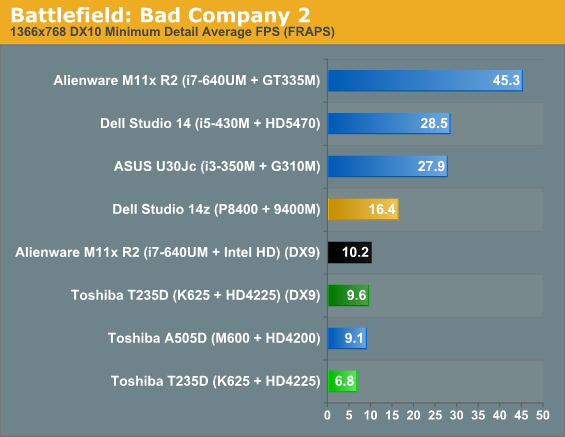
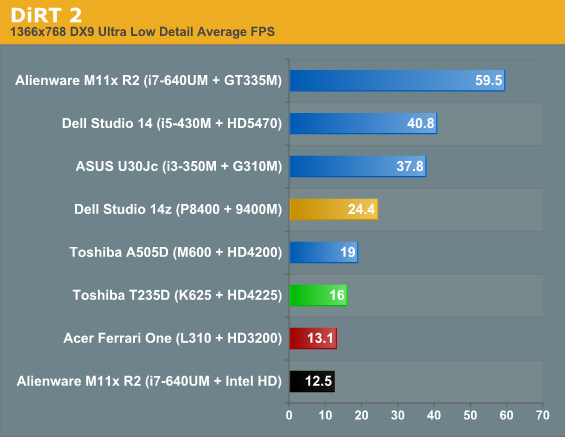
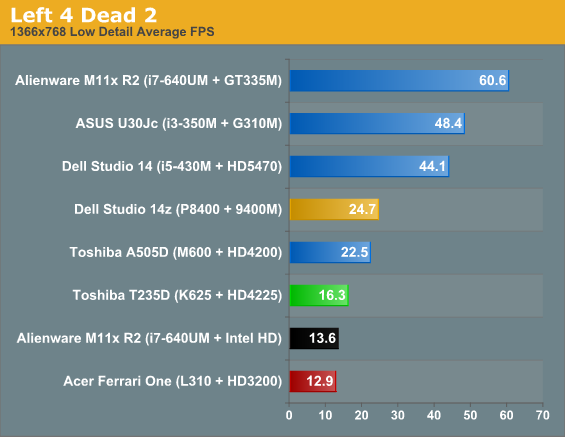
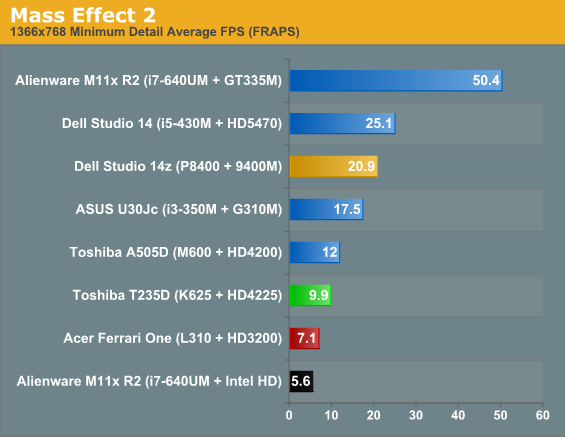
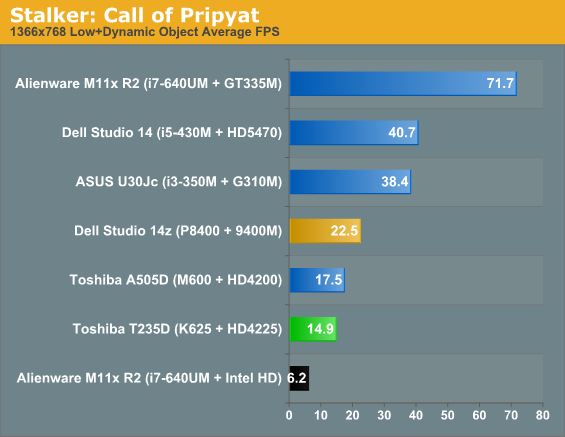

Sadly, gaming performance is poor at best. Compared to last year's NVIDIA 9400M, the 4225 offers anywhere from about half to two-thirds the performance. The HD 4200 is the same chip with a higher clock (500MHz vs. 380MHz), and it typically outperforms the 4225 by 20 to 30 percent as well. The best-case test for the T235D right now as a gaming option is actually StarCraft II, where the Studio 14z (9400M) and the T235D are basically tied. Our test sequence is a typical Zerg rush against a fortified Terran base, though we have seen much lower frame rates in heavy combat scenarios (i.e. the single-player mission "In Utter Darkness" will often drop into the low teens on many laptops).
Looking at the Intel side of the map doesn't radically alter our perceptions of the HD 4225. In DX9 mode, Intel manages slightly higher performance with Battlefield: Bad Company 2, but none of the IGPs reach anything close to acceptable performance. The remaining games all favor the ATI solution by anywhere from ~25% up to as much as 140%, and at 1366x768 the i7-640UM IGP is incapable of acceptable performance on any of the games we tested. So score one for ATI over Intel with the current graphics solutions, but here's hoping Bobcat, Fusion, and Sandy Bridge can give us integrated graphics that look more like NVIDIA's G 320M instead—or to put it in concrete terms, at least double the number of stream processors/graphics pipelines from the current IGPs.
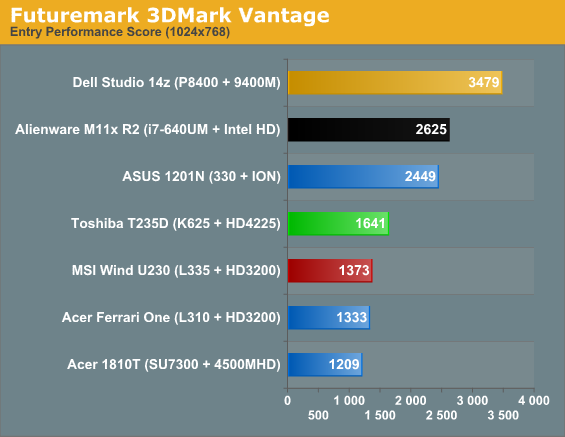
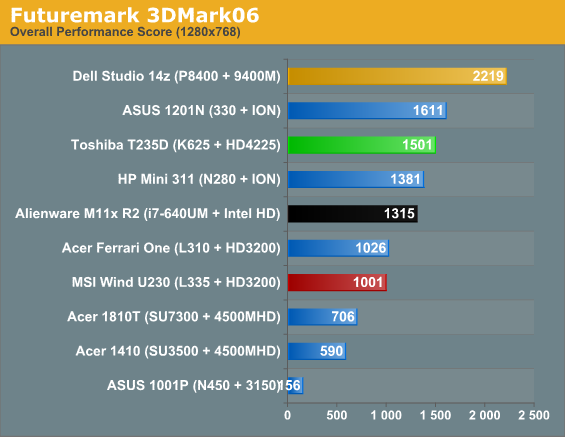
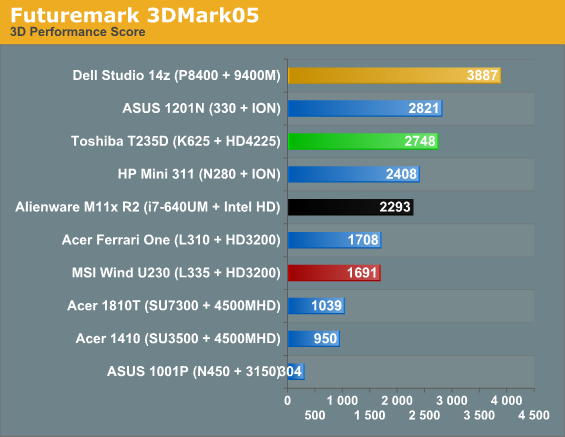
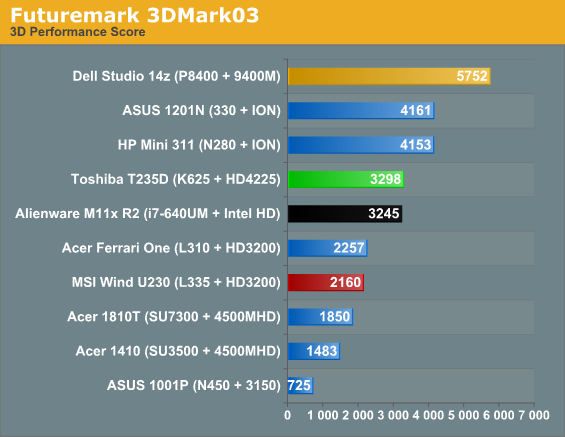
3DMark doesn't really add anything to the above gaming summary, though Intel's HD Graphics/platform obviously score a lot higher in Vantage than seems reasonable. The old 9400M is up to twice as fast as HD 4225, and that's a 16 core part compared to the new G 320M with 48 cores. Also something to note is that the new HD 4225 does consistently outperform the old HD 3200 in Congo by a sizeable margin, but then 25 to 65 percent faster than "really slow" is still too slow.










34 Comments
View All Comments
mczak - Wednesday, August 25, 2010 - link
per-clock performance of HD3200 and HD4200 is pretty much the same. The difference here (aside possibly from clock - not sure what clock the hd3200 used in the other notebooks were running at) is the platform. Most notably the HT speed, which was limited to HT-800 for Congo platform instead of HT1600 (for the K625). This basically halves the memory bandwidth available to the GPU and as you can guess this has a pretty disastrous effect on performance. Other differences are possible as well (e.g. different sideport memory), I believe some congo designs also ran their (ddr2) memory at a very low clock which could further lower scores though unless it was single channel it shouldn't make much of a difference since the HT-800 limits available gpu memory bandwidth still more. Well it could be a combination of slow memory and slow HT but whatever the case it's a bandwidth problem not architectural differences which make the HD3200 and HD4200 perform differently (unless you had an app which would use DX10.1 features).Hyperion1400 - Tuesday, August 24, 2010 - link
"Of course, battery capacities are a bit tricky—I know I have some 2500mAh 1.2V AA Energizer rechargeable batteries that suck compared to some equivalently rated 2500mAh Eneloop rechargeables"IxV gets you rated output(max power output assuming 0 ohm resistance). The only way to know the capacity of a battery is to rely on the manufacturer's word or to test the battery yourself.
Computer Bottleneck - Tuesday, August 24, 2010 - link
I think it is really interesting that older 45nm Intel's like SU7300 score better in battery tests than 32nm Arrandale i7-640um (found in Alienware M11 R2).Does this have anything to do with differences in peripherals (hard-drive, LCD, etc)? I noticed the Alienware has a 7200 rpm drive whereas the Acer Timeline 1810 has a 520 rpm drive. Or is the battery life difference related more to other factors? (I was expecting 32nm to definitely pull away from 45nm all things being equal).
JarredWalton - Tuesday, August 24, 2010 - link
I don't think most of the components make much of a difference. M11x isn't the most power-friendly implementation of Arrandale ULV, though, so we'll see how the ASUS UL80Jt stacks up next week. In general, though, the IGP in Arrandale is far more potent than the old GMA 4500MHD, and perhaps that's part of the difference.Intel specs the Arrandale ULV chips at 18W, which includes graphics. The CULV stuff was 10W, but I don't have a clear number on the chipset+IGP. It would appear that the chipset tops out at around 3W-5W for the IGP based on my testing here:
http://www.anandtech.com/show/2932/intel-core-2-cu...
Idle power draw on CULV may also be better, for whatever reason. Maybe 32nm has higher leakage, or it's just the number of transistors. I keep thinking the next 32nm parts from Intel will probably show much better power numbers, as this is really their first 32nm part. We'll see later this year with Sandy Bridge I guess.
strikeback03 - Tuesday, August 24, 2010 - link
All the testing with any Arrandale (ULV or not) has shown battery life not really improved from the later C2D processors, correct? Maybe there will be an improved stepping at some point.Computer Bottleneck - Wednesday, August 25, 2010 - link
Good point about Arrandale ULV possibly having higher leakage at idle. Maybe this is because i7-640um needs to be built on higher power wafers in order to hit the 2+ Ghz turbo speeds?Kishkumen - Tuesday, August 24, 2010 - link
As usual, the display just kills it all for me. A fine review, I just wish these laptop manufactures would throw us a freakin bone when it comes to some better displays. They're not doing themselves any favors with my pocket book anyway.Taft12 - Tuesday, August 24, 2010 - link
If you're referring to 1366x768, I fully agree!!Dell doesn't allow you to customize the screen nearly as much as they used to. Come on already, I am not paying over $600 for a laptop with that screen resolution!
The Crying Man - Tuesday, August 24, 2010 - link
Nice review. Is there any in the works with the N930 paired with an HD 5650? I have the dv6, but I'm just curious where it falls compared to all the other review laptops.JarredWalton - Tuesday, August 24, 2010 - link
I've got a P920 with 5650 review coming, but I do wish the CPU were faster. It's the Toshiba A665D... except the A665D is now discontinued and so my replacement system is the A660D. It's the same notebook but with a 7200RPM HDD AFAICT. Should have that up in the next week or so.